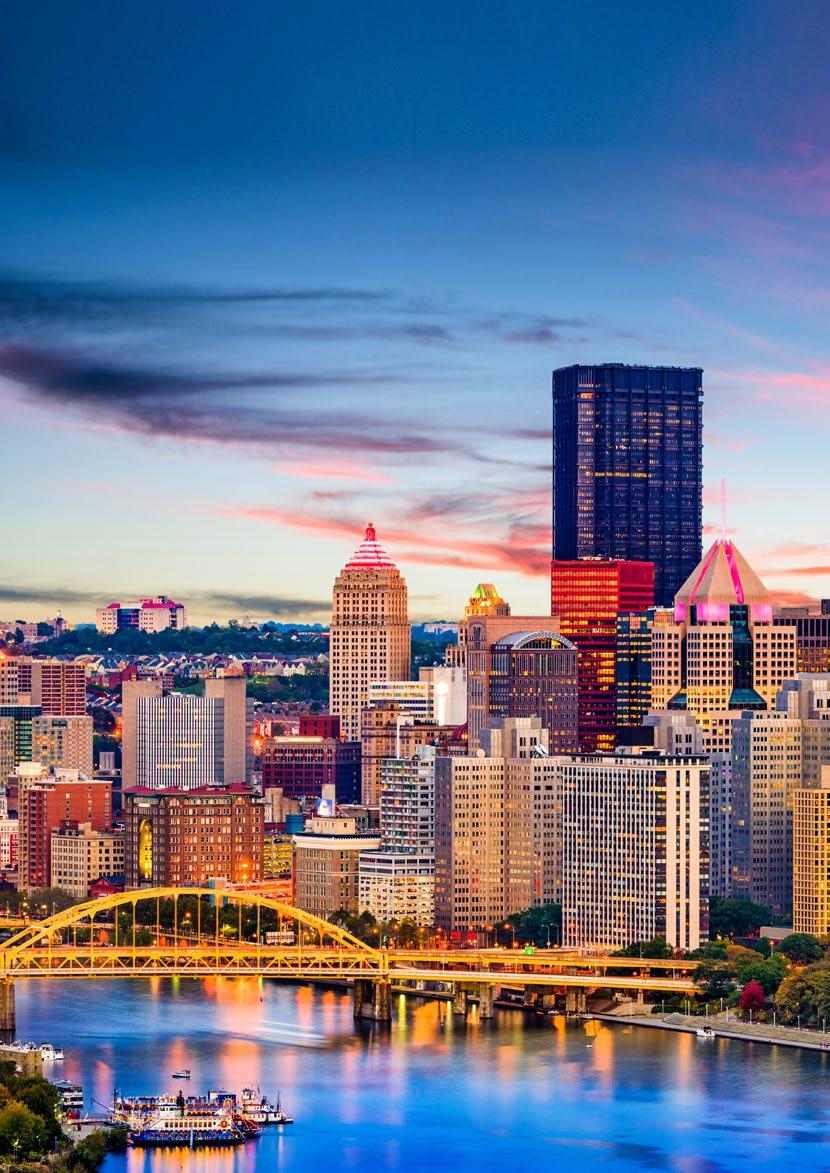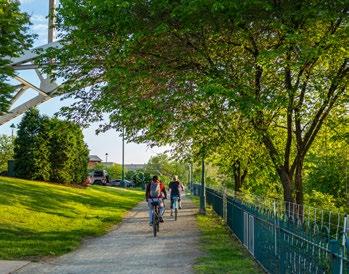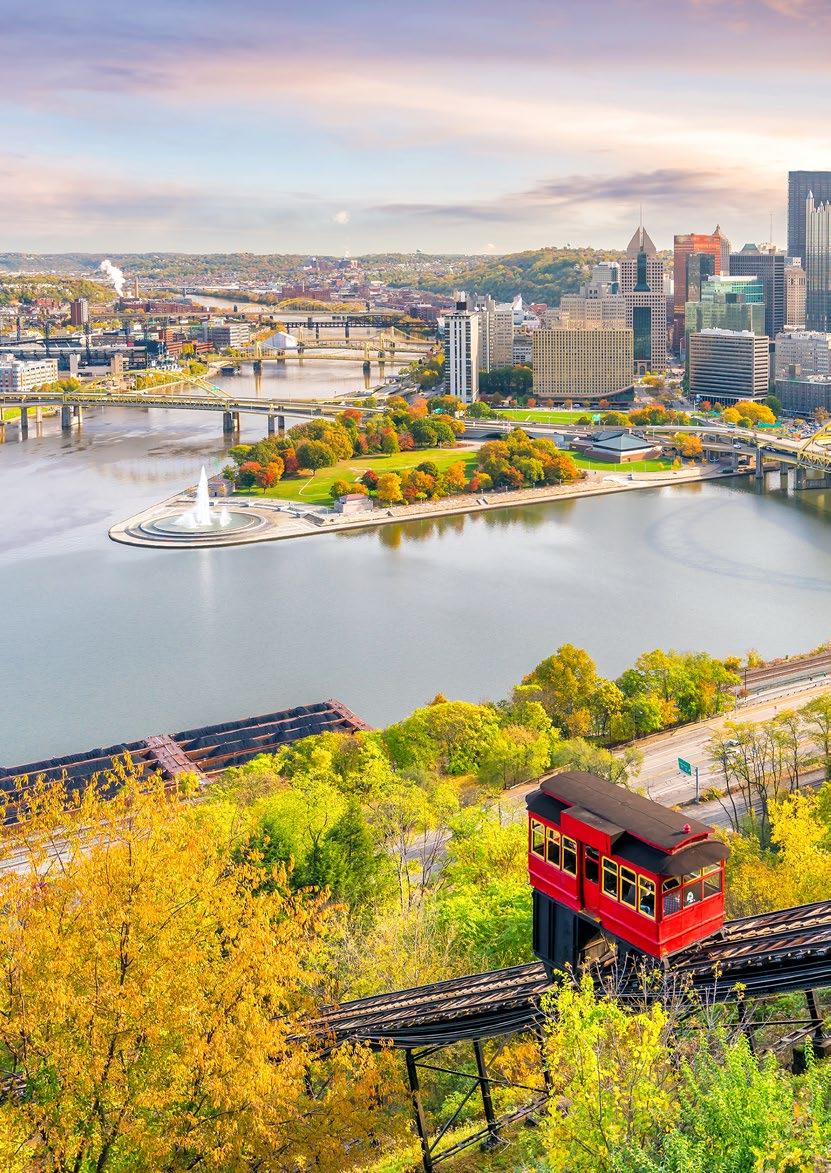
7 minute read
Low Season Traveller - Issue 6
A hilly maze of neighbourhoods, spectacular views, and lively entertainment in a post-industrial setting

Low Season: January-March
By Robert Isenberg
As every Pittsburgher will tell you, you simply have to take a picture at the top of Mount Washington. That’s what Grandview Avenue was built for – so you could stand on the edge of an observation platform and snap a photo in front of downtown Pittsburgh. In the background of every portrait, the river valley spreads far and wide, with handsome skyscrapers rising in the middle. Tourists come here. Newlyweds come here. Teens and retirees and college grads come here – all to take in one of the most spectacular urban skylines in America.
This is especially true in fall, when the leaves slowly change color over Pittsburgh’s rolling hills. Autumn days feel especially crisp in Western Pennsylvania, when the humidity has faded and Steelers fans excitedly pull on their football jerseys.
For a full century, the Steel City was pitied and mocked as an industrial wasteland, with blackened skies and coalstained row houses. But Pittsburgh has enjoyed decades of passionate redevelopment, showcasing the beauty and potential of Rust Belt communities. Today, the city boasts world-class museums, universities, urban parks, and dining options. The David L. Lawrence Convention Center draws conventioneers from around the globe, and an exploding film scene has made Pittsburgh’s vistas familiar to an entire generation of viewers, thanks to locally shot Netflix series (Mindhunter, The Chair) and Hollywood blockbusters (The Dark Knight Rises, A Man Called Otto).

Pittsburgh’s colonial history dates back to Fort Duquesne, a French outpost that, back in the 18th century, marked the frontier of westward expansion. The V-shaped convergence of the Allegheny and Monongahela Rivers into the Ohio River made Pittsburgh a vital inland port, and the rise of steel mills attracted immigrants from all over Europe. Even now, Pittsburgh is a patchwork of 90 distinct neighborhoods, from Bloomfield (nicknamed ‘Little Italy’) to the North Side (formerly ‘Deutschtown’) to the nearvertical slopes of Polish Hill.
Piece by piece, the Industrial Age infrastructure has been adapted for the 21st Century. Freight lines have been transformed into miles of bike paths. An abandoned basilica has been repurposed as the Church Brew Works. The remnants of gears and blast furnaces decorate the walkways of Station Square. Meanwhile, Pittsburgh is home to more bridges than almost any city on Earth, from highway overpasses to Steam Age trestles.
Museum City
Business magnate Andrew Carnegie was both loved and loathed in Pittsburgh, but one of his great legacies is the Carnegie Museum of Art. This massive modernist complex houses an impressive collection of paintings and statues, along with rotating exhibits and the quadrennial Carnegie International. Housed in the same building is the familyfriendly Carnegie Museum of Natural History, heralded by a gigantic brontosaurus sculpture outside, and the Carnegie Library, one of the finest indoor public spaces in the state.
Museum-goers will find plenty to love in Pittsburgh, hometown of both painter Mary Cassatt and scientist Jonas Salk. The Carnegie Science Center houses robots, model trains, and a complete submarine. The Andy Warhol Museum is a multi-storey gallery dedicated to the groundbreaking pop artist. The Mattress Factory contains giant rooms with avant-garde installations. And Bicycle Heaven is a converted warehouse with the largest array of bicycles in the world.
Pittsburgh has a feisty arts scene, largely based in the ‘Cultural District’ downtown. Visitors can find block after block of theaters, galleries, and public art, as well as the August Wilson Center, an African American cultural hub named after the Pulitzer Prize-winning playwright.
Sports Capital
When Pittsburghers speak of ‘the black and gold,’ they’re talking about sports, but you’ll have to clarify which one. The Penguins are the city’s beloved hockey team, which has won the Stanley Cup five times. The Pittsburgh Pirates have been playing baseball since the 1880s, and the stadium offers one of the most breathtaking views of downtown Pittsburgh.
But Pittsburghers go most berserk for the Steelers, longtime darlings of American football. The Steelers have storied past – including six Super Bowl wins – but the franchise was most successful during the 1970s, when the city’s steel industry started to crumble and residents needed a major pick-me-up. On game days, the stands (and streets) are packed with fans waving ‘Terrible Towels.’ Local fervor for athletics can’t be overstated: A statue of champion running back Franco Harris stands in the middle of Pittsburgh International Airport, right next to a statue of George Washington.
Fall is football season in the States, and if you happen to be in town on a Sunday, brace yourself for some enthusiastic crowds.
FOOD & DRINK
Primanti Brothers Sandwich
Pittsburgh is the birthplace of Heinz ketchup and the Big Mac, but no culinary invention is more beloved than the Primanti Brothers sandwich, which mashes meat, cheese, coleslaw, tomato and chips between two slices of bread. This hearty treat began as a grab-and-go meal for Depression-era truckers eager to hit the highway.
Growing Gastronomy Scene
Pittsburgh has always been known for its pubs and diners, which once served shiftfuls of laborers. But the city routinely surprises visitors with its wealth of dining options: The university district of Oakland has a range of international cuisine, including Indian, Mexican, and Thai eateries. The long list of high-end restaurants includes Apteka, whose chefs were recent finalists for a James Beard Award. Inventive pop-ups and gourmet burger joints are scattered throughout the city; just don’t tell your cardiologist.
Local Lagers and Whiskeys
And there’s no better place to grab a drink: Pittsburgh boasts more bars per capita than any other city in the U.S., not even counting the scores of microbreweries that emerged in the past few years. A traveler could spend weeks just sampling local lagers and whiskeys.


INSIDER TIPS
• More than just a rainy city, Pittsburgh is one of the most overcast in the country. No matter what season (including winter), visitors should plan to bring an umbrella and some kind of rain gear. Most of this rain is light and intermittent, but if you’re banking on sunny weather, make sure to have some indoor backups planned.
• Driving is a thrill in Pittsburgh, and GPS is your friend. The washboard hills and valleys have resulted in chaotic street patterns, and the cobblestone byways and weather-induced potholes can wreak havoc on your car. Here you’ll find the steepest street in America as well as a succession of, er, creative intersections. Keep an eye out for ‘parking chairs,’ which residents use to illegally reserve their spots.
• The Steel City isn’t known for luxury or resorts, but Downtown has plenty of upscale hotels, clustered among prime examples of historic architecture. Hotels get exponentially more expensive as you approach the city centre, but a good rule of thumb is not to stay beyond ‘the tunnels,’ as Pittsburgh’s suburbs are sleepy and feel farther away than they are.
GOOD TO KNOW
Pittsburgh has bred some of the country’s most impressive writers, including Michael Chabon, Annie Dillard, and Rachel Carson. To get a feel for the city, you may enjoy Chabon’s The Mysteries of Pittsburgh or the stage play Fences by August Wilson. (The film adaptation, filmed locally, is also excellent).
Mill workers usually labored within walking distance of their houses. To help their onfoot commute, the city built hundreds of outdoor staircases, which run up and down the breakneck hills. These concrete walkways are still essential today, connecting residents to neighbors and local stores.
While you’re there, book a ride on the Duquesne Incline, a 140-year-old funicular that ascends the slopes of South Side. What’s at the top? Why, Mount Washington. Make sure to snap a selfie!





